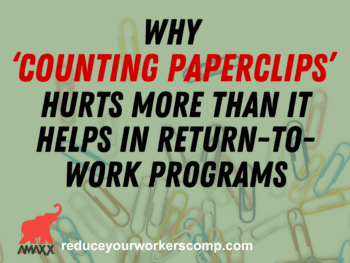
-
Place an Emphasis on Safety
Having a safe work environment and reducing the frequency and severity of work injuries is the best offense when reducing workers’ compensation program costs. There are many things interested stakeholders can do as they move into 2023 to ensure their programs are hitting the mark.
- Review safety training and determine if it is practical for your work environment. It is essential to consider how it is received within the workplace and make changes;
- Determine if workplace safety is being emphasized consistently. This should be addressed at weekly team meetings and in all company publications. Proper placement of safety-related signage is also crucial; and
- Require upper management to practice what they preach when it comes to safety. When leaders within an organization emphasize safety, others will take note and follow.
Now is the time to review safety within your workplace.
Click Link to Access Free PDF Download
“13 Research Studies to Prove Value of Return-to-Work Program & Gain Stakeholder Buy-In”
-
Ensure Injuries are Reported Promptly
Review how incidents are reported within your workplace and be ready to make a change. Items to consider include how employees are trained to report work injuries, the preparedness of supervisors and managers to complete required forms, and follow through that ensures all documents are submitted promptly.
- Review the consistency of data submitted following a work injury and whether it is creating problems for the claims team;
- Determine the “cost” of time lost when reporting a claim and determine if technology-driven options would make a difference; and
- Ensure existing claim reporting platforms allow the employee, witnesses, and supervisor/manager to provide the necessary information.
This review can also determine if the right reporting tools for your workplace are available.
-
Focus on Post-Injury Response and Return to Work
This review goes beyond determining if the first aid kit is properly stocked and easily accessible. An effective post-injury response review requires various items:
- Determine if all supervisors and managers can administer basic first aid to an injured employee;
- Provide all employees with access to telephonic nurse triage services. This will allow people to diagnose non-life-threatening injuries and best direct medical care properly;
- Establish a Preferred Provider Organization (PPO) to best direct post-injury medical care. While employees are generally free to select their treating doctor, nothing prevents suggesting a medical provider.
Every post-injury response must include an emphasis on return to work.
-
Provide Supervisors and Managers with Proper Training
Supervisors and managers play a vital role in the push to reduce workers’ compensation program costs. Upper management must ensure they have the right people to assist in the claims process.
- Promote high workplace morale – treating all employees with respect and dignity will motivate people to come to work. This includes after a work injury;
FREE DOWNLOAD: “13 Research Studies to Prove Value of Return-to-Work Program & Gain Stakeholder Buy-In”
- Examine opportunities for return to work efforts in an entire duty or modified capacity; and
- Consistent follow-up and contact with injured employees following an incident.
Supervisors and managers should also be willing to drive an injured employee to a healthcare facility following a work injury if care is needed. They should also be willing to make regular contact with someone injured on the job, whether in-person, via telephone, or by sending a “get better soon” card.
-
Emphasize Compassion and Empathy
Nobody heads to work in the morning thinking they will sustain an injury – including something life-altering. Compassion and empathy are often overlooked in workers’ compensation programs. All employees should be addressed in a non-judgmental and compassionate manner following an injury.
Conclusions
It is never too late (or early) to review your workers’ compensation program and make changes. Waiting to implement change means extra dollars are spent – so do not delay. The new year provides an excellent opportunity to examine your program and make needed changes. Interested stakeholders can focus on safety, injury response, and training during this process. It is also necessary to consider compassion and empathy. These steps can help reduce workers’ compensation costs and improve your program.

Contact: mstack@reduceyourworkerscomp.com.
Workers’ Comp Roundup Blog: http://blog.reduceyourworkerscomp.com/
©2022 Amaxx LLC. All rights reserved under International Copyright Law.
Do not use this information without independent verification. All state laws vary. You should consult with your insurance broker, attorney, or qualified professional.
FREE DOWNLOAD: “13 Research Studies to Prove Value of Return-to-Work Program & Gain Stakeholder Buy-In”

















